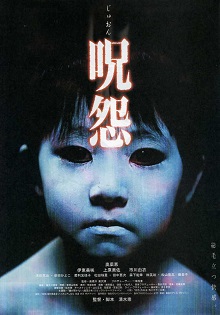Sunday, March 4, 2012
Foreign Fears: Ju-on: The Grudge (呪怨) (2003)
review by Nickolas Cook
Believe it or not, it was only recently that I sat down to watch the original J-horror version of the American remake (directed by the same director of the original). I have been put off in recent years by the overabundance of J-horror after having seen a dozen or so of them that didn't offer much than the ocassional 'BOO!' moment and very little story. And if I have one complaint about "Ju-On: The Grudge" that is probably it. Although I have to admit the movie had some rather startling imagery to offer, and the sound effects especially were disquieting as hell.
The story is a simplistic one--when a person or persons is murdered and leaves his/her rage behind, the furious spirit or spirits inhabits the domicile and basically attacks anyone silly enough to come in contact with them. Not much of a story to worry about, but the director and writer of the film, Takashi Shimizu, understands that and uses the simplistic idea to scare the crap out of his viewer anyway. But he doesn't pick on one protagonist in his non-linear horror film. Instead, he uses six different vignettes and multiple characters to tell how the two spirits--Kayako, the frightening young woman onryo, with hair that kills, and Toshio, the little boy onryo, who seems more of a trapped spirit in most of the vignettes than an enraged one--and how they entangle themselves into those lives, finally ending them in horrible ways.
It doesn't take long for the viewer to realize that "Ju-On: The Grudge" isn't going to have a storyline that has a beginning and an ending, as we start with a young couple traveling in a car at night (on a suspiciously empty major highway) who are discussing the young woman's new role in a movie that is being shot in a supposedly haunted location. That's about the only exposition you can expect from "Ju-On: The Grudge" as the first couple is in an accident that leads to contact with another person, who becomes involved in the house's past, and so on and so on.
But it sure as hell isn't the tangential characters that we're concerned with. It's the appearances of the two pissed off spirits. And that's the true strength of the film: when those two evil ghosts come on screen, it is always in a particularly scary event. But it's more than just scares; the director/writer uses these moments to tie together the six different stories and characters--from either an earlier scare moment, or from one which takes place later. I won't give away the scenes, because to do so would be to give away the frightening moments in the film. I don't won't to spoil it for anyone who, like myself until recently, haven't yet seen it. Let's just say, be prepared for some very disturbing images and sound effects.
So is it a must see film?
Well, in the larger context of understanding the history of horror cinema, yes. Very much so. After all, the film was a huge success in its home country and, like the same production team's earlier success, "Ringu" (1998), it jumped the J-horror borders and became a success internationally--enough so that horror-God Sam Raimi produced an American remake in 2004. But if you're coming to the film for big scares after seeing the American remake, then you're most likely going to be a little disappointed.
--Nickolas Cook

